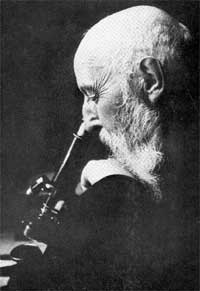Dr. Gerhard Armauer Hansen

Gerhard Henrik Armauer Hansen was the Norwegian physician who discovered that leprosy was caused by a particular bacterium known as Mycobacterium leprae in 1873.
Hansen was born in 1833, and earned his degree at the Royal Frederick's University in 1866. In 1868, Hansen, together with Daniel Cornelius Danielssen, returned from a short internship at the National Hospital in Christiania, as well as a doctor in Lofoten.
Leprosy was considered highly hereditary because 90% of humans are naturally resistant to acquiring the disease. Hansen concluded, on the basis of epidemiological studies, that leprosy was a specific disease with a specific cause.
Due to Hansen's need to gain the proper medical knowledge and instruction in order to prove his hypothesis, Hansen traveled to Bonn and Vienna to gain the necessary training in 187-1871. In 1873, he announced the discovery of Mycobacterium leprae in the tissues of all who attained leprosy. However, he received little support to back up his hypothesis. Hansen gave Albert Neisser a sample of the bacteria to examine in 1879, and in 1880, Neisser announced that he has successfully stained and took full scientific credit for discovering the agent that causes leprosy. As a result Neisser and Hansen went to war in claiming the scientific credit, but Hansen's claim was injured by his failure to produce a pure microbiological culture in an artificial medium, or to prove that therod-shaped organisms were infectious. Later, on a more controversial note, Hansen tried to infect a female patient with the disease without her consent, which ultimately removed him from his position as a doctor.
Hansen had suffered from syphilis since the 1860s, but died of heart disease.
Hansen was born in 1833, and earned his degree at the Royal Frederick's University in 1866. In 1868, Hansen, together with Daniel Cornelius Danielssen, returned from a short internship at the National Hospital in Christiania, as well as a doctor in Lofoten.
Leprosy was considered highly hereditary because 90% of humans are naturally resistant to acquiring the disease. Hansen concluded, on the basis of epidemiological studies, that leprosy was a specific disease with a specific cause.
Due to Hansen's need to gain the proper medical knowledge and instruction in order to prove his hypothesis, Hansen traveled to Bonn and Vienna to gain the necessary training in 187-1871. In 1873, he announced the discovery of Mycobacterium leprae in the tissues of all who attained leprosy. However, he received little support to back up his hypothesis. Hansen gave Albert Neisser a sample of the bacteria to examine in 1879, and in 1880, Neisser announced that he has successfully stained and took full scientific credit for discovering the agent that causes leprosy. As a result Neisser and Hansen went to war in claiming the scientific credit, but Hansen's claim was injured by his failure to produce a pure microbiological culture in an artificial medium, or to prove that therod-shaped organisms were infectious. Later, on a more controversial note, Hansen tried to infect a female patient with the disease without her consent, which ultimately removed him from his position as a doctor.
Hansen had suffered from syphilis since the 1860s, but died of heart disease.
